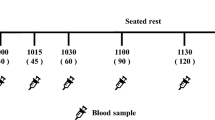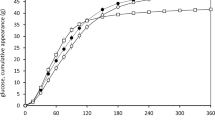Abstract
Background:
There is evidence linking oral propionate to a reduction in food intake, which could confer functional food properties in the fight against obesity. However, propionate is typically volatile with a pungent smell and taste and so incorporating into foods naturally, at levels acceptable to the consumer is a novel approach.
Subjects/methods:
Twenty healthy, young, normal weight unrestrained eaters underwent an acute feeding study using a palatable sourdough and an identical control bread of a similar palatability, in a randomized cross-over balanced design for the assessment of appetite and energy intake.
Results:
No difference in energy intake of an ad libitum test meal, 180 min after the bread-based breakfast or in energy and macronutrient intake over the entire 24 h period was found between breads. Visual analogue scale ratings for appetite were not influenced by bread type, except the desire to eat something sweet. Elevated plasma insulin concentrations were observed following the propionate-rich sourdough breakfast (P=0.033 no effects of treatment on postprandial glycaemia were found.
Conclusions:
These findings suggest propionate-rich sourdough bread does not influence appetite and food intake unlike larger doses of the food preservative N-propionate.
This is a preview of subscription content, access via your institution
Access options
Subscribe to this journal
Receive 12 print issues and online access
$259.00 per year
only $21.58 per issue
Buy this article
- Purchase on Springer Link
- Instant access to full article PDF
Prices may be subject to local taxes which are calculated during checkout


Similar content being viewed by others
References
Foresight. Tackling obesities: future choices – Project report: Government Office for Science 2007. 2007 Report No., 2nd ed.
Food Standards Agency. National Diet and Nutrition Survey Headline results from Year 1 of the Rolling Programme (2008/2009). HMSO2010: Norwich. 2008/2009.
Al-Lahham SH, Peppelenbosch MP, Roelofsen H, Vonk RJ, Venema K . Biological effects of propionic acid in humans; metabolism, potential applications and underlying mechanisms. Biochim Biophys Acta 2010; 1801, 1175–1183.
Cummings JH, Pomare EW, Branch WJ, Naylor CP, Macfarlane GT . Short chain fatty acids in human large intestine, portal, hepatic and venous blood. Gut 1987; 28, 1221–1227.
Liljeberg HGM, Bjorck IME . Delayed gastric emptying rate as a potential mechanism for lowered glycemia after eating sourdough bread: studies in humans and rats using test products with added organic acids or an organic salt. Am J Clin Nutr 1996; 64, 886–893.
Liljeberg HGM, Lonner CH, Bjorck IME . Sourdough fermentation or addition of organic acids or corresponding salts to bread improves nutritional properties of starch in healthy humans. J Nutr 1995; 125, 1503–1511.
Todesco T, Rao AV, Bosello O, Jenkins DJA . Propionate lowers blood glucose and alters lipid metabolism in healthy subjects. Am J Clin Nutr 1991; 54, 860–865.
Darwiche G, Ostman EM, Liljeberg HGM, Kallinen N, Bjorgell O, Bjorck IME et al. Measurements of the gastric emptying rate by use of ultrasonography: studies in humans using bread with added sodium propionate. Am J Clin Nutr 2001; 74, 254–258.
Ge H, Li X, Weiszmann J, Wang P, Baribault H, Chen JL et al. Activation of G protein-coupled receptor 43 in adipocytes leads to inhibition of lipolysis and suppression of plasma free fatty acids. Endocrinology 2008; 149, 4519–4526.
Hong YH, Nishimura Y, Hishikawa D, Tsuzuki H, Miyahara H, Gotoh C et al. Acetate and propionate short chain fatty acids stimulate adipogenesis via GPCR43. Endocrinology 2005; 146, 5092–5099.
Karaki S, Tazoe H, Hayashi H, Kashiwabara H, Tooyama K, Suzuki Y et al. Expression of the short-chain fatty acid receptor, GPR43, in the human colon. J Mol Histol 2008; 39, 135–142.
Tazoe H, Otomo Y, Kaji I, Tanaka R, Karaki SI, Kuwahara A . Roles of short-chain fatty acids receptors, GPR41 and GPR43 on colonic functions. J Physiol Pharmacol 2008; 59, 251–262.
Tazoe H, Otomo Y, Karaki S, Kato I, Fukami Y, Terasaki M et al. Expression of short-chain fatty acid receptor GPR41 in the human colon. Biomed Res 2009; 30, 149–156.
Brown AJ, Goldsworthy SM, Barnes AA, Eilert MM, Tcheang L, Daniels D et al. The Orphan G protein-coupled receptors GPR41 and GPR43 are activated by propionate and other short chain carboxylic acids. J Biol Chem 2003; 278, 11312–11319.
Le Poul E, Loison C, Struyf S, Springael JY, Lannoy V, Decobecq ME et al. Functional characterization of human receptors for short chain fatty acids and their role in polymorphonuclear cell activation. J Biol Chem 2003; 278, 25481–15489.
Xiong Y, Miyamoto N, Shibata K, Valasek MA, Motoike T, Kedzierski RM et al. Short-chain fatty acids stimulate leptin production in adipocytes through the G protein-coupled receptor GPR41. Proc Natl Acad Sci USA 2004; 101, 1045–1050.
Mepham B . Food additives: an ethical evaluation. Br Med Bull 2011; 99, 7–23.
Frost GS, Brynes AE, Dhillo WS, Bloom SR, McBurney MI . The effects of fiber enrichment of pasta and fat content on gastric emptying, GLP-1, glucose, and insulin responses to a meal. Eur J Clin Nutr 2003; 57, 293–298.
Darzi J, Frost GS, Robertson MD . Do SCFA have a role in appetite regulation? Proc Nutr Soc 2011; 70, 119–128.
Maioli M, Pes GM, Sanna M, Cherchi S, Dettori M, Manca E et al. Sourdough-leavened bread improves postprandial glucose and insulin plasma levels in subjects with impaired glucose tolerance. Acta Diabetol 2008; 45, 91–96.
Najjar AM, Parsons PM, Duncan AM, Robinson LE, Yada RY, Graham TE . The acute impact of ingestion of breads of varying composition on blood glucose, insulin and incretins following first and second meals. Br J Nutr 2009; 101, 391–398.
International Organisation for Standardisation. Sensory analysis - Guidelines for the use of quantitative response scales BS ISO 4121:20032003. 2003.
International Organisation for Standardisation. Sensory analysis - Methodology - Triangle test BS ISO 4120:20042004. 2004.
International Organisation for Standardisation. Sensory analysis - Methodology - General guidance BS ISO 6658:20052005. 2005.
International Organisation for Standardisation. Sensory analysis - Methodology - Paired comparison test BS ISO 5495:20052005. 2005.
International Organisation for Standardisation. Sensory analysis - Methodology - Ranking BS ISO 8587:20062006. 2006.
van Strien T, Frijters JER, Bergers GPA, Defares PB . The Dutch Eating Behavior Questionnaire (DEBQ) for assessment of restrained, emotional, and external eating behavior. Int J Eat Disord 1986; 5, 295–315.
Flint A, Raben A, Blundell JE, Astrup A . Reproducibility, power and validity of visual analogue scales in assessment of appetite sensations in single test meal studies. Int J Obes Relat Metab Disord 2000; 24, 38–48.
Hill AJ, Blundell JE . Nutrients and behaviour: research strategies for the investigation of taste characteristics, food preferences, hunger sensations and eating patterns in man. J Psychiatr Res 1982; 17, 203–212.
Bryant M, Truesdale KP, Dye L . Modest changes in dietary intake accross the menstrual cycle: implications for food intake research. Br J Nutr 2006; 96, 888–894.
Bodinham CL, Frost GS, Robertson MD . Acute ingestion of resistant starch reduces food intake in healthy adults. Br J Nutr 2010; 103, 917–922.
Caumo A, Bergman RN, Cobelli C . Insulin sensitivity from meal tolerance tests in normal subjects: a minimal model index. J Clin Endocrinol Metab 2000; 85, 4396–4402.
Bellisle F, Louis-Sylvestre J, Demozay F, Blazy D, Le Magnen J . Cephalic phase of insulin secretion and food stimulation in humans: a new perspective. Am J Physiol 1985; 249, E639–EE45.
Just T, Pau HW, Engel U, Hummel T . Cephalic phase insulin release in healthy humans after taste stimulation? Appetite 2008; 51, 622–627.
Robertson MD, Jackson KG, Williams CM, Fielding BA, Frayn KN . Prolonged effects of modified sham feeding on energy substrate mobilization. Am J Clin Nutr 2001; 73, 111–117.
Teff KL, Engelman K . Oral sensory stimulation improves glucose tolerance in humans: effects on insulin, C-peptide, and glucagon. Am J Physiol 1996; 270, R1371–R13R9.
Feldman M, Richardson CT . Role of thought, sight, smell, and taste of food in the cephalic phase of gastric acid secretion in humans. Gastroenterology 1986; 90, 428–433.
Pavlov IP . The Work of the Digestive Glands. Charles Griffin Co. Ltd.: London, 1902.
Heath RB, Jones R, Frayn KN, Robertson MD . Vagal stimulation exaggerates the inhibitory ghrelin response to oral fat in humans. J Endocrinol 2004; 180, 273–281.
Pouderoux P, Veyrac M, Michel H . Sham feeding disrupts phase III of the duodenal migrating motor complex in humans. Neurogastroenterol Motil 1995; 7, 139–144.
De Graaf C, De Jong LS, Lambers AC . Palatability affects satiation but not satiety. Physiol Behav 1999; 66, 681–688.
Yeomans MR . The role of palatability in control of human appetite: Implications for understanding and treating obesity: appetite and body weight. In: Kirkham TC, Cooper SJ (eds). Appetite and Bodyweight Regulation: Integrative Systems and the Development of Anti-obesity Drugs. Academic Press: New York, 2007, pp 247-269.
Nisbett RE . Taste, deprivation, and weight determinants of eating behavior. J Pers Soc Psychol 1968; 10, 107–116.
Wicks D, Wright J, Rayment P, Spiller R . Impact of bitter taste on gastric motility. Eur J Gastroenterol Hepatol 2005; 17, 961–965.
Wolever TM, Spadafora P, Eshuis H . Interaction between colonic acetate and propionate in humans. Am J Clin Nutr 1991; 53, 681–687.
Allen MS, Bradford BJ, Oba M . Board Invited Review: the hepatic oxidation theory of the control of feed intake and its application to ruminants. J Anim Sci 2009; 87, 3317–3334.
Diplock AT, Aggett PJ, Ashwell M, Bornet F, Fern EB, Roberfroid MB . Scientific concepts of functional food in Europe: consensus document. Br J Nutr 1999; 81, S1–S28.
Acknowledgements
We are grateful to all the volunteers who participated in the study and also to Drs Shelagh Hampton and John Wright for medical assistance. JD was involved in designing and conducting the research, analysed the data and wrote the paper. MDR was involved in designing the research and refining the paper. GSF was involved in designing the research, refining the paper. All authors read and approved the final manuscript. JD was supported by an educational fellowship from Premier Foods and bread test products were manufactured and supplied by Holgran Ltd (Burton-on-Trent, UK).
Author information
Authors and Affiliations
Corresponding author
Ethics declarations
Competing interests
The authors declare no conflict of interest.
Rights and permissions
About this article
Cite this article
Darzi, J., Frost, G. & Robertson, M. Effects of a novel propionate-rich sourdough bread on appetite and food intake. Eur J Clin Nutr 66, 789–794 (2012). https://doi.org/10.1038/ejcn.2012.1
Received:
Revised:
Accepted:
Published:
Issue Date:
DOI: https://doi.org/10.1038/ejcn.2012.1
Keywords
This article is cited by
-
Beneficial effect of the short-chain fatty acid propionate on vascular calcification through intestinal microbiota remodelling
Microbiome (2022)
-
Role of Gut Microbiota-Generated Short-Chain Fatty Acids in Metabolic and Cardiovascular Health
Current Nutrition Reports (2018)
-
Modulation of mitochondrial function by the microbiome metabolite propionic acid in autism and control cell lines
Translational Psychiatry (2016)
-
Influence of the tolerability of vinegar as an oral source of short-chain fatty acids on appetite control and food intake
International Journal of Obesity (2014)



